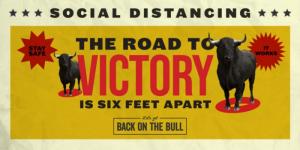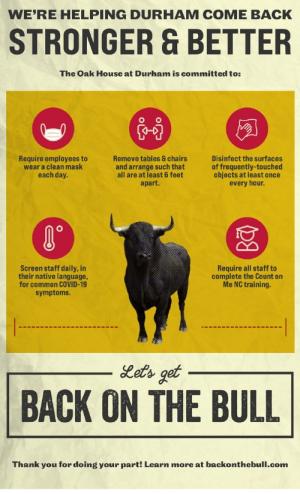Why Durham built behavioral ‘nudges’ into its reopening plans

When businesses in Durham, N.C., began reopening their doors back in May, Ryan Smith and Mariel Beasley put on their face masks and went on a trip together to a local shopping mall. They wanted to see how businesses were translating all the new rules and public-health guidance around COVID-19 into concrete actions to keep their customers and employees safe.
It was a question both of them had a particular interest in. Smith, who normally heads Durham’s innovation team, is for the time being serving as staff director for Mayor Steve Schewel’s task force focused on safely reopening the local economy. Beasley is a behavioral-science expert with Duke University’s Center for Advanced Hindsight, and a frequent collaborator with Smith’s team of City Hall innovators.
What they found as they walked around the mall, observing, snapping photos, and taking notes, was a mixed bag of compliance that city leaders everywhere can identify with. Some businesses were putting a lot of effort into it, handing out face masks and sanitizer at the door, using clear signage to remind people to practice physical distancing, and putting markers on the floor to help customers stay apart. Others were doing practically nothing. Customers, too, were all over the place when it came to wearing face masks, for example.
By the time they left the mall, Smith and Beasley already had an inkling of an idea that would develop into a public campaign Durham is launching today. It’s called “Let’s Get Back on the Bull” — a reference to Durham’s “Bull City” nickname. At a time when many small business owners across the country are struggling with a new and often contentious role in enforcing public-health rules, and many local governments are focusing on fining, shaming, or shutting down businesses for COVID noncompliance, Durham is taking a different approach. It’s focused on creating a standard of excellence for businesses to aspire to, and giving them tools to get there.
For example, the campaign’s website boils down all the public health guidance for different types of businesses into a simple and actionable checklist. Businesses who fill out the checklist, noting the health-and-safety steps they are taking, are entered into a database that residents can search in order to patronize establishments that are taking COVID precautions seriously. More than 160 businesses did this already during a “soft launch” of the site last week, including retailers, restaurants, hotels, dental offices, childcare facilities, and places of worship, and many more are expected to follow now that the city is putting a marketing push behind it. Slick posters of bulls wearing masks and social distancing, designed for free by the Durham-based advertising firm McKinney, are available for business owners to print and pin up on their walls and doors.
From top to bottom, Durham’s approach is informed by behavioral science, also known as “nudging” — a critical innovation tool that a growing number of cities are learning how to use. The idea is to continually present choices residents and business owners make in a way that makes them more likely to pick the option that benefits them and society by hindering the spread of the coronavirus. That’s why Smith asked a behavioral scientist to join him at the mall that day in May. She and her team volunteered many hours of work into the project. “Mariel was the very first person I reached out to,” he said, “because I knew behavioral science was going to be really key to this work. So much of it is about how to inspire voluntary compliance.”
One critical component is the heath and safety checklist itself. Simple checklists have been proven to be powerful tools for surgeons, for example, to reduce mistakes and improve health outcomes for patients. Beasley and Smith thought the same approach would help for businesses. The idea, Beasley said, was to create “really clear, actionable tasks businesses could do based on CDC guidelines, and make it easy to follow through on those things. Where the checklist asks if you’ve posted a sign to remind employees to wash hands, for example, you can click a link for a sign that pops up and print it right away.”
There are several other ways Let’s Get Back on the Bull is informed by insights from behavioral research. Beasley and Smith outlined some of them here.
Starting with the research. The trip to the mall, simply to observe what’s going on, was the first step. “One of the first things we do in a behavioral science process is observe what’s happening,” Beasley said. “We need to do a diagnosis. We need to understand what’s going on.” Next, Beasley’s team at Duke put together a “behavioral brief” assembling what science knows about human behaviors that could impact the likelihood of people complying — or not complying — with health guidelines.
Underneath it all, Beasley said, lie some assumptions. One is that most people actually do want to comply — and when they don’t, it’s most likely simply due to inattention. Another is that small barriers, or what Beasley calls friction, can get in the way of compliance. “For businesses, it’s a little extra effort to post good signage, or to put tape on the floor to encourage social distancing,” Beasley said. “So we really thought about how can we reduce the friction so that both businesses and residents can do the things they need to do?”
[Read our explainer: What is a behavioral nudge?]
Using social norms. We’re all social beings, and we take cues from those around us. If it seems like everyone is wearing a mask, it communicates that it’s normal behavior; the opposite is also true.
Let’s Get Back on the Bull plays on this in a few ways. The public database of COVID precautions businesses are taking is meant to put a bit of peer pressure on owners, not only to be part of the effort but also to raise their game to match or exceed what steps their competitors are taking. The campaign also will also publicize photos of people around Durham engaging in safe behaviors. “We have a gallery of pictures of businesses and people that are complying,” Beasley said, “We want to show that it’s really normal to comply — and very abnormal not to.”
Offering choices to inspire a sense of agency. Some people have a gut reaction to rebel against mandates, Beasley said, so it’s important to offer choices of ways they can achieve a desired outcome. The checklist for businesses, for example, is framed around suggestions for different ways they can get to successful social distancing. That’s better than mandating all to use a certain strategy, like curbside pickup.
“There’s research in behavioral science that shows if you tell someone to do something specific, you can trigger a negative reaction, like you’re impinging on their freedom,” Beasley said. “But by giving them some suggestions and asking which of them they’ll do, you’ve introduced some agency and an element of choice that can actually increase compliance.”
[Read: 7 behavioral insights tips from pioneering cities in the field]
Recognizing peoples’ efforts. Businesses earn recognition for participating in Let’s Get Back on the Bull in a number of ways. They get listed in the public database, where residents who want to shop safely can find out about what precautions they’re taking. (Residents also can search specifically for Black- or minority-owned businesses if they’re interested in supporting businesses of color.) They get a custom poster to print, with their business name on it, announcing the top five things they’re doing to stop the spread of the virus, as well as a list of all precautions they can share with staff.
Other benefits include a free and confidential assessment of the COVID risks associated with their type of business, based on information from the Johns Hopkins Bloomberg School of Public Health. All of this is meant to build confidence among customers and employees alike about coming back to work or going out to shop, and doing so responsibly based on public health guidance.
“For residents who are concerned about finding safe places to go visit, here’s a transparent way to see the steps businesses are taking,” Smith said. “We think that is going to be a strong incentive for businesses to participate.”



